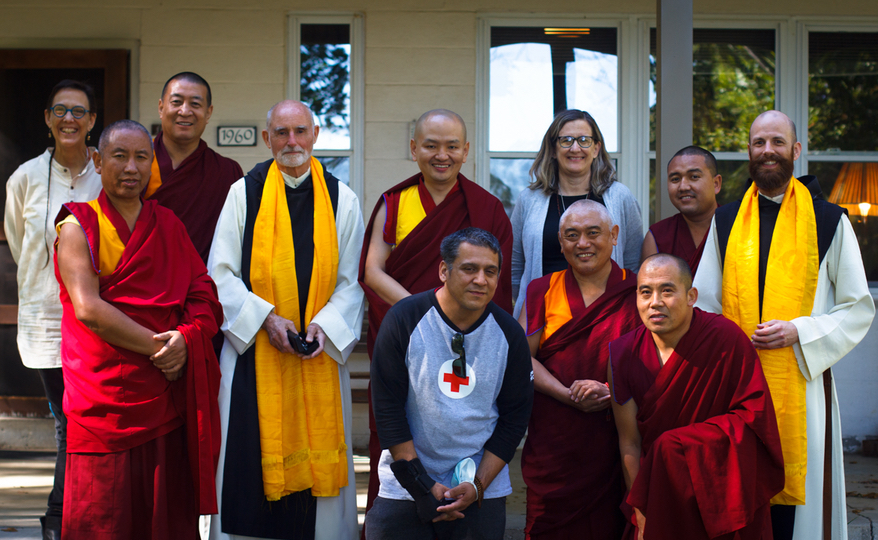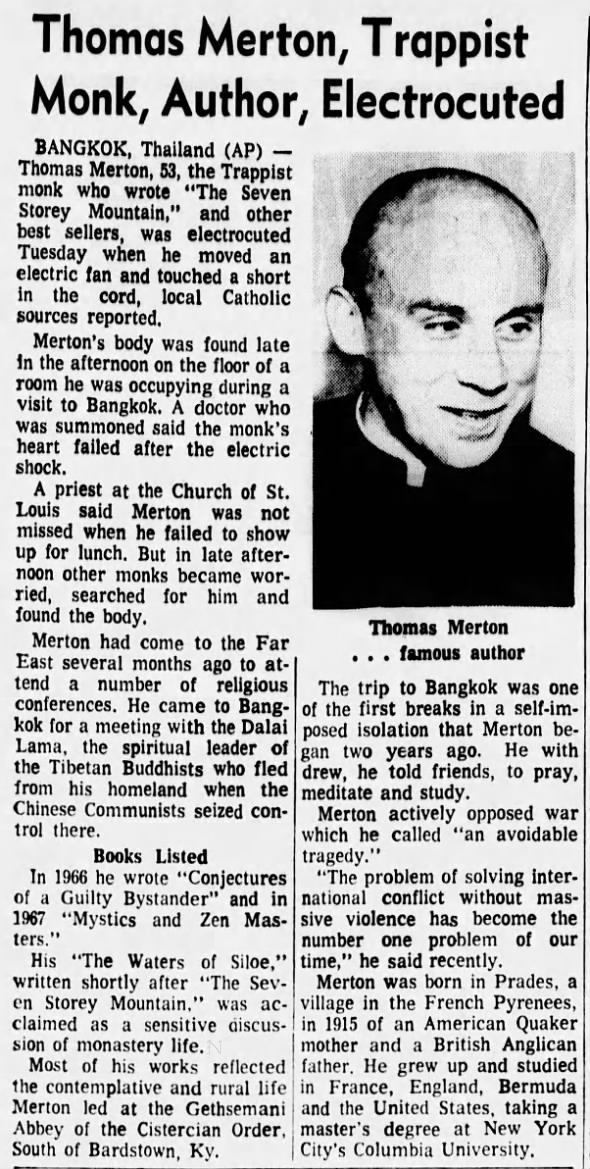Including the latest incarnation of the ‘Wisdom Buddha’…
Kentucky Trappists receive Buddhist Monks

The famous Abbey of Gethsemani near Bardstown, Kentucky, had some special guests the other day.
The Trappist Novus Ordo monks were visited not only by “Buddhist friends and guests”, as they write on their official web site, but very specifically by “His Eminence” Kundeling Tatsak Rinpoche. In case the name doesn’t sound familiar, the Trappists inform us that he is “not merely a teacher, but an emanation of Manjushri, the Wisdom Buddha, the current incarnation of a long and renowned lineage.” Can’t beat that!
Mr. Kundeling is a 40-year-old Tibetan who lives in India. He was in the United States for a lecture series on the “thirty-seven practices of a Bodhisattva” and other “Dharma teaching” at the Drepung Gomang Center for Engaging Compassion in nearby Louisville, Kentucky.
The full report posted on the monastery web site reads as follows:
For quite a few years now, the Abbey of Gethsemani has had a close relationship with the Drepung Gomang Center in Louisville, Kentucky. This temple is associated with its motherhouse in India, and when notable Buddhists come to the temple, they often fit in a visit to Gethsemani, in part to honor Thomas Merton who was a friend to the Dalai Lama.
However, due to the pandemic, it has been a long time since visits from India were possible, and even then, Gethsemani itself was closed to visitors. But on the 27th of September [2022], our relationship resumed.
The occasion was a visit to Drepung Gomang by the noted Buddhist teacher H.E. Kundaling Tatsak Rinpoche. He is not merely a teacher, but an emanation of Manjushri, the Wisdom Buddha, the current incarnation of a long and renowned lineage. While he was there, he gave a public talk, some Dharma teaching, and other presentations. He was also able to come to Gethsemani for an afternoon, along with Geshe Rapgyal, the head of the Drepung Gomang temple, the monks who live there, Anne Walter, the director of the temple, and others.
We met at the abbey, and walked out to the hermitage where Thomas Merton spent his last years. Br. Paul, Br. Lazarus, and Fr. Lawrence accompanied them. Br. Paul read from Merton’s journals about his meetings with the Dalai Lama when he in India, on his way to the conference in Bangkok. The Rinpoche spoke about the importance of the relationship between Buddhism and other religions, in our case Christianity, which the Dalai Lama consistently emphasizes..
It was a thoroughly enjoyable afternoon.
We at Gethsemani were very glad to have our relationship with the Drepung Gomang temple renewed and we look forward to many more visits in the future.
(“Buddhist friends and guests visit”, Abbey of Gethsemani, Oct. 11, 2022)
The abbey is somewhat famous, for to it belonged, as noted in the post, the well-known Trappist author Thomas Merton (aka Fr. Louis Merton). Merton died by accidental electrocution near Bangkok, Thailand, on Dec. 10, 1968, while attending an interreligious conference.

No doubt Fr. Merton would have been pleased with the Buddhist visit to the monastery in Kentucky.
It may not be politically correct to say so, but the fact remains that Buddhism is a false religion, and as such it is a great danger to souls. A brief Catholic critique of the errors of Buddhism can be found in Fr. Reginald Garrigou-Lagrange, On Divine Revelation, vol. 2, pp. 540-543 (purchase through link benefits Novus Ordo Watch).
The “wisdom” which Buddhism claims to bring to the world is not the wisdom of God: “For the wisdom of this world is foolishness with God” (1 Cor 3:19). There is no doubt that even Buddhism may contain certain natural truths that can be deduced from reason, but its dogmas, as Fr. Garrigou-Lagrange writes, “manifestly do not surpass natural reason. Nay, they are very inferior to the conclusions of sound philosophy. For it teaches nothing concerning God” (On Divine Revelation, vol. 2, pp. 540-541; italics removed).
As St. Paul warned the Colossians: “Beware lest any man cheat you by [false] philosophy, and vain deceit; according to the tradition of men, according to the elements of the world, and not according to Christ” (Col 2:8). The Holy Gospel, being the true supernatural revelation of the Most High God, tramples under foot the false wisdom of the world: “For it is written: I will destroy the wisdom of the wise, and the prudence of the prudent I will reject. Where is the wise? Where is the scribe? Where is the disputer of this world? Hath not God made foolish the wisdom of this world? For seeing that in the wisdom of God the world, by wisdom, knew not God, it pleased God, by the foolishness of our preaching, to save them that believe” (1 Cor 1:19-21).
The move towards a “Catholic” acceptance of Paganism began with the apostate Second Vatican Council (1962-65). Its decree on non-Christian religions claims that “Buddhism, in its various forms, realizes the radical insufficiency of this changeable world; it teaches a way by which men, in a devout and confident spirit, may be able either to acquire the state of perfect liberation, or attain, by their own efforts or through higher help, supreme illumination” (Nostra Aetate, n. 2).
It is precisely this optimism concerning false religions — based on the mistaken idea that one can legitimately praise certain true and holy “elements” in them, as if these religions existed in elements and not only as a whole — that was condemned by the Catholic Church before Vatican II:
When [Sir Edwin] Arnold’s Light of Asia appeared [a work promoting Buddhism –N.O.W.], not a few Catholics joined in the chorus of fulsome praise which greeted it. How charming, how beautiful, how tender, how pathetic, how humane; what lofty morality, what exquisite sentiment! Now what was the real purport of the book and what was its essence? To lift up Guatama, the founder of Buddhism, at the expense of Jesus Christ, the Founder of Christianity! The intention was to show that Guatama was equally a divine teacher with as high an aspiration, as great a mission, as lofty a morality as our Divine Lord Himself. This was the object of the book; what was its essence? A falsification of history by weaving a series of poetical legends around a character, about whose actual life practically nothing is known. But not only this, the character was built up upon the model of Our Lord, which the author had in his own mind as the precious heirloom of Christianity; and his Gautama, whom he intended to stand out as at least the divine equal of the Founder of Christianity, became in his hands in reality a mere echo of Christ, the image of Christ, made to rival the Word made flesh! Buddhism, in the borrowed garments of Christianity, was thus made to appeal to the ideals of Christian peoples, and gaining a footing in their admiration and affections, to usurp the throne in the Christian sanctuary. Here was a work of literary merit, although it has been greatly exaggerated in this respect, praised extravagantly by some Catholics who, in their excessive desire to appear impartial, failed or refused to see in Edwin Arnold’s Light of Asia a most vicious, anti-Christian book! What difference does it make whether a book be excellent in a literary sense or not, if its effect be the loss of souls and not their salvation? What if the weapon in the hands of the assassin be bright or not, if it be fatal? Though spiritual assassination be brilliant, it is nonetheless deadly.
Heresy under a charming disguise is a thousand times more dangerous than heresy exposed in the harsh and arid garb of the scholastic syllogism — through which the death’s skull grins in unadorned hideousness. Arianism had its poets to propagate its errors in popular verse. Lutheranism had its humanists, amongst whom the elegant Erasmus shone as a brilliant writer. Arnauld, Nicole, Pascal threw the glamour of their belles lettres [essays] over the serpentine doublings of Jansenism. Voltaire’s wretched infidelity won its frightful popularity from the grace of his style and the flash of his wit. Shall we, against whom they aimed the keenest and deadliest shafts, contribute to their name and their renown! Shall we assist them in fascinating and corrupting youth! Shall we crown these condemners of our faith with the laurels of our praises and laud them for the very qualities which alone make them dangerous! And for what purpose? That we may appear impartial? No. Impartiality is not permissible when it is distorted to the offense of truth, whose rights are imprescriptible. A woman of bad life is infamous, be she ever so beautiful, and the more beautiful, the more dangerous. Shall we praise Liberal books out of gratitude? No! Follow the liberals themselves in this, who are far more prudent than we; they do not recommend and praise our books, whatever they be. They, with the instinct of evil, fully appreciate where the danger lies. They either seek to discredit us or to pass us by in silence.
Si quis non amat Dominum Nostrum Jesum Christum, Sit anathema [“If anyone does not love the Lord Jesus Christ, let him be anathema”], says St. Paul. Liberal literature is the written hatred of Our Lord and His Church. If its blasphemy were open and direct, no Catholic would tolerate it for an instant; is it any more tolerable because, like a courtesan, it seeks to disguise its sordid features by the artifice of paint and powder?
(Rev. Felix Sarda y Salvany, Liberalism is a Sin, Chapter 18; some formatting changed; underlining added.)
This book, Liberalism is a Sin, was first published in Spanish in 1886. It received the highest recommendation from the Holy See under Pope Leo XIII, as noted in the preface. Interestingly enough, the book refutes many principles and ideas that later won the day at Vatican II, after the false popes John XXIII and Paul VI had begun to usurp the Chair of St. Peter.
The disastrous consequences that abominable council has had for souls cannot be overstated. Decades later, we can see clearly the devastation it has caused.
In 2014, Buddhist and Shintoist rituals were conducted in the Catholic cathedral of Santiago de Compostela, Spain. In 2017, the superior of the Jesuits, the notorious “Fr.” Arturo Sosa, visited a temple in Cambodia. Of course Buddhism also features prominently every time the interreligious prayer for peace shenanigans take place in Assisi, Italy — you can thank “Saint” John Paul II for that.
No one has made greater moves towards accepting Pagan religions than the Argentinian Jesuit Jorge Bergoglio, also known as “Pope Francis”. While visiting Myanmar in 2017, the false pope gifted a Vatican (!) edition of The Life of Buddha to the country’s president, who expressed his astonishment. In 2019, Bergoglio claimed that God positively wills there to be many different religions and taught that religious differences “are necessary”. In 2021, Francis spontaneously expanded the “People of God” to include members of all religions and presented the false religions of the world as “different ways of coming to God” — as if Christ our Lord were not the Only Way (see Jn 14:6) and His Church the only Ark of Salvation. Just last month, the Jesuit pseudo-pope told the Swiss Guards at the Vatican that they needed to “recognize cultural, religious, and social diversity as a human wealth [enrichment] and not as a threat.”
So, no wonder the Kentucky Trappists were excited about being visited by Mr. Kundeling and friends.
Image source: monks.org
License: fair use



No Comments
Be the first to start a conversation